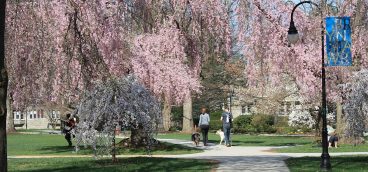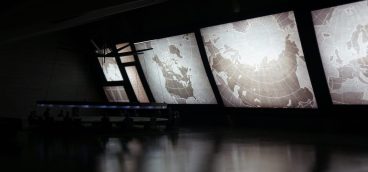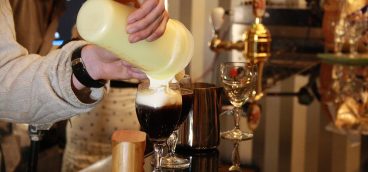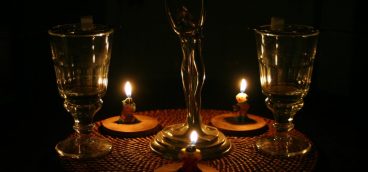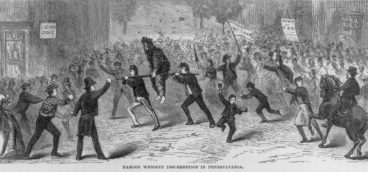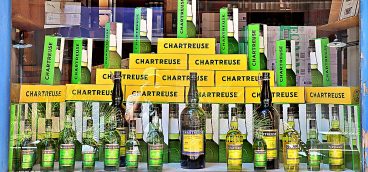Touring with the Big Shots

The typical family unit on my tour was a mom, a dad, and a 17-year-old kid who was a prospective student. But one day an unusual unit showed up – a kid and his gorgeous older sister. Well, well, well, I thought.
Previously in this series: How Not to be a College Guide
The third stop on every tour was a dormitory because, of course, mom and dad wanted to see how their darling would be living if he matriculated at the college. Unsurprisingly, the college insisted that for this stop on the tour I take the folks over to the “Gold Coast,” where the rich boys lived, and up to Room 300, the best room at the college, reserved for senior suck-ups.
I had perpetrated this fraud three times a day for many weeks, but today I had a different idea. I took the tour group over to my dorm, a rickety firetrap situated at the far northwest fringe of the campus, and up to Room 205, my room.
While the tourists held their noses and averted their gaze from the malodorous mess, I caught the cute girl’s eye, pointed to her, then to me, then to my room. But the girl must have had the IQ of a housefly because she didn’t get it and never showed up.
One of the most trying aspects of the college guide business was having to give special tours to “dignitaries.” It wasn’t enough that I worked 8 a.m. to 6 p.m. and gave three tours a day seven days a week. No, I also had to give lots of special, one-off tours to muckety-mucks.
One morning I arrived at the gazebo to find that I was to give an 11 a.m. tour to no fewer than 13 muckety-mucks – a new world record! When they arrived, the men were wearing three-piece suits and the ladies, obviously spouses, were wearing sober dresses. I nearly said, “Who died?” but then realized that these folks were probably trustees of the college.
The special tours for dignitaries differed in two ways from the regular tours. In the first place, I had to take the muckety-micks to the exact places specified by the college and I had to say exactly what the college wanted me to say.
That was because the dignitaries typically went directly from their tour to lunch with the college president. Having had some sketchy experience with his college guide, the president would be sure to cross-examine the dignitaries carefully: “That kid didn’t say anything about murals and Mexicans, did he?”
The second way these tours differed was something that happened on no other college tour in the world. In addition to the normal tour stops I was to take the dignitaries over to the freshman dining hall, which was located in a dank alley back behind the other college buildings, and on my way to the dining hall I was to discuss an important piece of litigation the college had gotten itself involved in back in the day.
Let me pause here to report that all the tours that included the freshman dining hall had to take place early in the day. That was because the college had this quaint rule that freshmen had to “dress for dinner” – the cooks were instructed not to serve anyone who wasn’t wearing a necktie.
In the cloakroom at the dining hall there were 60 pegs on the wall and from each peg hung half a dozen pre-tied neckties. As you entered the dining hall itself, the spectacle before you was of several hundred ravenous freshmen all wearing cut-off jeans and tee shirts, all with a necktie hanging loosely around their necks.
But back to my litigation. The college had been founded and endowed in the middle of the eighteenth century as a private institution, but in 1816 the state the college was in decided to ignore the private nature of the school. Too cheap to start its own college, they seized this one and tried to turn it into a state college.
The college was naturally unenthusiastic about this idea and commenced litigation. It lost in the lower courts, naturally – those judges had all been appointed by the state governors and knew whence their bread was buttered.
But now the case was being heard before the United States Supreme Court, Chief Justice John Marshall presiding. The college’s case was argued by one of its alums, Daniel Webster, then the most famous lawyer in America.
As I led my distinguished tour group toward the freshman dining hall, I recited the facts of the case as they were being interpreted under the Contracts clause of the US Constitution and emphasized what was at stake: limiting the power of the states to interfere with private contracts and essentially enabling the American free enterprise system.
As we entered the dining hall my dignitaries could see, straight ahead, a gigantic painting of attorney Webster arguing before the Supreme Court. Having finished the legalistic part of his argument, Webster had now turned to the table-thumping part.
Looking Chief Justice Marshall straight in the eye, Webster thundered (the painting had subtitles), “It is sir, as I have said, a small college, and yet, there are those who love her!”
According to all reports, tears rained down the Chief Justice’s cheeks and the day was won.
And tears appeared in the freshman dining hall, too – eight strong men’s eyes watered up and five sober ladies dabbed at their eyes with hankies. Rolling my own eyes, I led the group out of the dining hall and back to the main campus.
An imposing trustee fell in step beside me and said, “Young man, you stated that court case very well.” (No kidding, I’d only done it 500 times.) “Have you considered going to law school?”
“No,” I said. “My plan is to marry a rich girl and spend the rest of my life doing nothing.”
Ha, ha, ha, of course I didn’t say that, although that’s what I was thinking.
What I actually said, was, “No sir, I hadn’t thought about it.”
“Well,” he said, “you should think about it. And if you decide to apply, be sure to give me a call.” He placed a business card in my sport coat pocket, which I promptly forgot about. Many weeks later I came across that card and learned that the imposing trustee was the famous Erwin Nathaniel Griswold, Dean of the Harvard Law School since 1946.
Next up: How Not to Be the College Guide, Part 3


